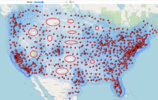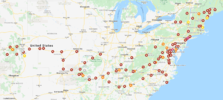OK I just wanted to share since I have tested a few cords, adapters, and plugs out there. Granted at home if possible you will want to go with as much power as possible but this works too, especially when traveling.
The setup is this:
Tesla Mobile charger
Tesla 6-20 plug
6-20 extension cord (25ft for me) --> https://www.amazon.com/gp/product/B07TCNT8ZB/
5-15p 12AWG to 20am T-Blade adapter --> https://www.amazon.com/gp/product/B08PNNMNC4/
14-50p to 6-20r Adapter
14-30p to 6-20r Adapter
Now the why (always remember that you should set your amps to the national standard of 80% the plug rating.) The Tesla Mobile charger auto detects voltage and sets the amp level based on the plug adapter used. Therefore you can plug into household 5-15 and 5-20 plugs using the 6-20 plug with the 5-15 adapter (linked above), and just adjust the amps (12amps for normal household plug 5-15) in your car based on which plug you are using. Next you can also use the 6-20 with 240v plugs like the 14-50 and 14-30 (obviously the 6-20 too) and no amp adjustments would be needed. The real bonus is that the extension cord is about the same as a 5-15 or 5-20 but MUCH smaller and lighter than a 14-50 or 14-30 yet can be used for both 120v and 240v.
So at max you going to get 16amp X 240v = 3840watts which is close to about 10MPH for my Model X. Which over night would recover and then some from whatever vacation spot we are visiting. If you don't want to worry about changing the amps (or tripping a breaker) you could get the 6-15 but that will lower your max charge rate to 2880watts.
For those in a rental property it is a lot less of a hassle to convert a 5-15 to a 6-15 or a 5-20 to a 6-20 (search the forums for input and ask an electrician)
With the right adapters I got this all to fit in the Tesla mobile charger bag, thus not taking up more room!
Thoughts?
The setup is this:
Tesla Mobile charger
Tesla 6-20 plug
6-20 extension cord (25ft for me) --> https://www.amazon.com/gp/product/B07TCNT8ZB/
5-15p 12AWG to 20am T-Blade adapter --> https://www.amazon.com/gp/product/B08PNNMNC4/
14-50p to 6-20r Adapter
14-30p to 6-20r Adapter
Now the why (always remember that you should set your amps to the national standard of 80% the plug rating.) The Tesla Mobile charger auto detects voltage and sets the amp level based on the plug adapter used. Therefore you can plug into household 5-15 and 5-20 plugs using the 6-20 plug with the 5-15 adapter (linked above), and just adjust the amps (12amps for normal household plug 5-15) in your car based on which plug you are using. Next you can also use the 6-20 with 240v plugs like the 14-50 and 14-30 (obviously the 6-20 too) and no amp adjustments would be needed. The real bonus is that the extension cord is about the same as a 5-15 or 5-20 but MUCH smaller and lighter than a 14-50 or 14-30 yet can be used for both 120v and 240v.
So at max you going to get 16amp X 240v = 3840watts which is close to about 10MPH for my Model X. Which over night would recover and then some from whatever vacation spot we are visiting. If you don't want to worry about changing the amps (or tripping a breaker) you could get the 6-15 but that will lower your max charge rate to 2880watts.
For those in a rental property it is a lot less of a hassle to convert a 5-15 to a 6-15 or a 5-20 to a 6-20 (search the forums for input and ask an electrician)
With the right adapters I got this all to fit in the Tesla mobile charger bag, thus not taking up more room!
Thoughts?





